Flash In The Pan: Will Sail For Food
Transoceanic Shipping Has A Huge Carbon Footprint, But What If Goods Came Via Sailboat?

Latest Article|September 3, 2020|Free
::Making Grown Men Cry Since 1992

